
|
 |

|
 |
KAY POURSINE, DISCIPLE OF GURU T. BALASARASWATI A Remarkable Student of a Legendary Dance Genius by Padma Chebrolu 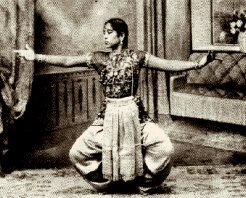
T. Balasaraswati at young age Feb 2002 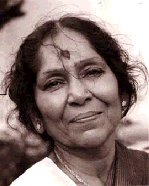 T. Balasaraswati(1918-1984) ; Photo: Jan Steward It is not too far-fetched to say everyone in the dance world has heard about the legendary T. Balasaraswati (1918 - 1984). Younger generations study this great dancer's life and art form to carry on Bala's great tradition into the next millennium. One such student of Bala is Kay Poursine from Connecticut, one of the most humble, sincere and dedicated dancers who crossed the boundaries of culture, religion and geography to be accepted by Bala as her student. It is not only Kay's dedication to the art but her divine calling that brought Kay to Bala's dance school. Some of us could only dream to study under such a supreme artist. In my recent conversation with Kay Poursine, she gave us insights into her teacher(s), life and her philosophy about dance. 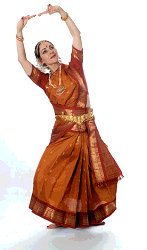
Photo by John Wareham Kay was born in New Orleans, the daughter of Augustine Poursine, the descendent of a French Creole family with deep roots in the city's history. Traveling extensively with her family in Japan, Europe, and the United States, she studied balled in Japan at age 6, continued in the United States and Germany until she was 17. While studying ballet in Sendai, Japan, she saw a performance of classical Thai dancing. Though mesmerized by the elaborate Thai hand gestures, she continued her training in ballet, but was never satisfied until she saw some years later as an undergraduate a performance of Bharata Natyam, the classical dance from South India. Kay studied with the great dancer, Bala first in Berkeley, California, then in subsequent summer workshops on the West Coast. Balasaraswati, invited her to Chennai for private classes, after which she received her M.A. from Wesleyan University. Subsequently, she studied and performed in India with the support of three Smithsonian senior fellowships under the auspices of the American Institute of Indian Studies in 1982-83, 1986-87, and 1990-91. Poursine's performances in India received rave reviews. While completing her MA at Wesleyan University, Ms. Poursine continued her music studies with Balasaraswati's brothers, T. Viswanathan and T. Ranganathan. She has performed and taught as a Visiting Artist in the Wesleyan Dance Department, the Wesleyan Graduate Liberal Studies Program and at residencies in the US and abroad. 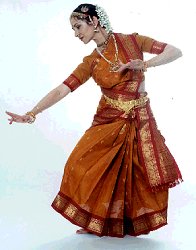
Photo by John Wareham Padma: What prompted you to start learning classical Indian dance? Kay: When I was 6 years old, I was living in Japan with my family. I learned ballet (Paris Opera style) from a Japanese teacher who also performed classical Thai dance. The elaborate and delicate use of hand gestures in Thai dance completely enthralled me and it was not until my sophomore year at Michigan State University that I saw an even more beautiful and intoxicating dance. When I saw Bharata Natyam in performance at MSU, I fell in love immediately with Carnatic music and the complex and sophisticated use of gestures to express meanings and emotions. For about four years after my graduation, I searched for a teacher that I felt could explain the beauty in this great art. It was not until I saw Balasaraswati perform and teach at Mills College, CA in 1972 that I knew that I had found my teacher! Padma: You had the opportunity to learn from one of the most famous dance teachers in the world. Did that intimidate you in anyway? Kay: My first experience with Balasaraswati was in an audition for placement in a class level (beginner, intermediate, advanced) at Mills College during her residency in 1972. Everyone I knew in New York City (where I lived at the time) told me Bala would probably not teach me because I had learned another style (Pandanalur) in Manhattan for one year and that it would be obvious to her. I was mortified to show her what I knew (tisram alarippu!) but Ramiah, her assistant nattuvanar at the time was very encouraging. Bala assured me that I should just dance and she would decide. After I performed alarippu, Bala looked at me very deeply and asked "You have obviously learned another style...do you want to learn my style of dance?" I said with all my heart "Yes..Bala!" She put me in the intermediate class and told Ramiah that she would look in and see my progress in a week or so. Padma: Was it very demanding? Kay: I worked extremely hard that first week trying to relearn the adavus (body and hands were very different), I actually had pain in my legs every night! Ramiah saw that I was trying very hard to correct my hands and adavu execution. After a week had passed, Bala came into my class, looked at me briefly and spoke in Tamil to Ramiah. After Bala left, Ramiah quickly motioned for me to come to him and said "Balama wants you to come into the advanced class ...now!" I almost floated to that room where the great dancer Balasaraswati was sitting and teaching. I could not believe my good fortune! You must understand that I saw Bala perform before I auditioned for her. I was profoundly moved by her dancing. She seemed to know everything when she moved. Her movements were so fluid, graceful and fully engaged with the music. She sang during the padams, javalis and sloka! Her voice seemed from another world or universe! I was mesmerized, just like everyone else. But now I had the great good fortune to be in a class and receive instruction from a master! My fear of Bala was primarily due to the fact that she was an incredibly deep person and when in front of her, you felt she saw deep into your soul. She taught not only dance and music, but she informed your soul also, in order that you danced from the deepest part of your being. I feel blessed that I had not only the chance to see a great artist perform, but also to have her accept me as a student and guide me until her death in 1984. I sincerely believe teachers continue to guide you even after death. 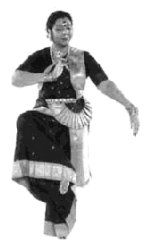 Lakshmi Knight Padma: Are you still continuing to learn or are you teaching now? Kay: I continued learning repertoire in Bala's style from Nandini Ramani after Bala died in 1984. It was a great blessing that Nandini accepted my proposals, both in 1987 and in 1990. I received AIIS grants both times. There are so few dancers who have learned this rare sampradaya and Nandini is the senior most disciple of this great living tradition. You may have heard that Bala's beautiful daughter Lakshmi died December 23, 2001 in Bala's house in Chennai. Lakshmi was an inspired performer and teacher. The dance world mourns the loss of such an extremely rare person and artist. I teach privately at present and conduct short week long and full semester residencies. I just finished a residency at Denison University, Granville, OH (Fall semester 2000). I taught Balasaraswati's sampradaya in the Dance Department at Wesleyan University as a Visiting Artist from 1981-1991. While in Madras on my third AIIS Grant, I decided to devote all my time to a professional career of performing and travel. Padma: As classical Indian dances are related to Hindu religion, how did the religion influence you when you immersed yourself into dancing? Kay: When Balasaraswati taught, she instilled a deep respect and love for the Hindu religion in my heart. I cannot imagine anyone performing this art and not dancing from the heart. Even though I am a Catholic Christian, I have a deep soul connection to the Hindu religion. This is because of Bala and the way she made the gods and goddesses come alive in her teaching. You felt that not only did you learn a story, but you also became acquainted with Lord Rama, Sita, Lord Krishna, Siva, etc. When Bala taught, the whole Hindu religion became alive and real. I felt that the stories and deities became a part of my life. When dancing in front of Bala, you felt you wanted to share this with her, to show her your profound gratitude for her great teaching! My life is informed by this art everyday and my dancing is informed by my life. That is what is meant by 'living tradition'. Padma: In your dance and academic career, what was the most fascinating experience or successful aspect? Kay: I've had many fascinating experiences in performance both in India and in the US. During Bala's residency at Univ. of WA 1974, I was chosen by Bala to portray Rama in the dance drama Dasavatara composed by Swati Tirunal. Bala started encouraging me to improvise emotions in parts of a scene with Sita and Lakshmana. I thought I would surprise her by improvising to the gamakas in the last part of the line of poetry. Just as I finished the line, Bala shouted "Wow!" Later she said she was in another world at that moment. There were other moments Bala encouraged me to improvise and use the music.... I continue to this day working on different ways to bring the poetry to life in the dance. It is only in improvisation that this style of Bharata Natyam truly flourishes. Teaching has great rewards, especially when I see a light of understanding flicker in a student's eyes or a new respect for this great art. Padma: What are your most memorable moments with Guru. Balasaraswati and other teachers? Kay: as above...many many others. Actually one of the most memorable moments was when Bala wanted me and three other American students studying with her in Madras in 1976 to experience the great Meenakshi Temple in Madurai. She convinced the temple priests to allow us to enter the sanctum sanctorum. I was deeply moved by the different atmosphere in the sanctum and the outer parts of the temple. Bala asked me to look at the faces of the older women who were trying to get a glimpse of the glittering image of Meenakshi in the darkness. Bala said "See her...look at her face.. she is with the divine...do not forget this!" Later we sat in the cool of the outer court of sanctum in front of the Navagraha images...I looked at Bala and thanked her from my heart. She said "You must understand these things if you are to dance the greatness of this art!' Padma: What is your advice for other performers and teachers who are contributing to the art of dancing? Kay: Dance and teach the heart of this dance. Without the heart you have nothing. 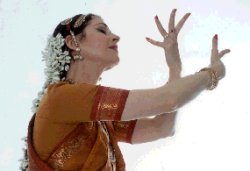 Photo by John Wareham Padma: You attend many conferences and workshops to bring more awareness about dances of India to the rest of the world. Can you tell us about it? Kay: I dance and teach what I have learned from Bala. My experience at conferences has been discouraging. I think if you have to talk about dance in panels, then you have lost your way. Too much blind leading the blind happens during conferences on dance. Why don't dancers just dance? Let the 'performing arts scholars' talk and watch. Padma: How has the scenario of Indian dance changed in your opinion over the past two decades in the US? Kay: I believe what has happened to Indian classical performing arts in the past two decades is no different than what happened seven centuries ago. Art changes and adapts to the times in which it exists. Bharata Natyam as we know it today certainly did not exist before 1945! What we see now is a synthesis of many classical styles (temple dance, court dance, dance dramas, etc.). I am very sure artists and critics were saying the same thing in 1026 A.D. India! Padma: Apart from your teachers, who do you admire or have worked with in the field of Indian dance? Kay: I admire Nandini Ramani and Dr. Saskia Kersenboom von Duren, Director of PARAMPARA in Utrecht, Holland. Of course, I admire Bala's brother, T. Viswanathan. His music is superb. I always loved to watch Bala's daughter Lakshmi Knight perform. Lakshmi was an excellent teacher as well! We have lost so much with her passing in December. During the past 5 months I have had the pleasure of getting to know Hari Krishnan, a disciple of the legendary Kittappa Pillai. Hari is the new Bharata Natyam instructor at Wesleyan University. I admire Hari not only for his devotion to his guru's family tradition, but also for his brilliant natturvangam and extraordinary choreography. He is a shining new light in the international dance scene! Padma: Your passion for Indian dancing is commending. What would you like to do in the rest of your dance career? Kay: I want to perform throughout the world and teach this style in my own school. I don't want to change the initial inspiration from Bala, I want to project it through my heart into my dancing and to my students. Bala asked me before her death in 1984 "You must dance this great art...you must show people the inspiration you have received.. you must dance my art...it is important!" Kay Poursine can be contacted at kpoursine@wesleyan.edu and more information can be found at her website, kpoursine.web.wesleyan.edu/kpours.htm Padma Chebrolu is the artistic director for Cultural Centre of India. She writes and produces videos related to dances of India. e-mail: padma@culturalcentreofindia.com You can visit the web site at culturalcentreofindia.com |